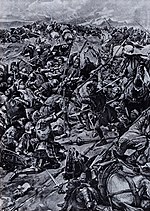Lake Milada
Artificial lakes of the Czech RepublicGeography of the Ústí nad Labem RegionÚstí nad Labem District

Lake Milada (Czech: Jezero Milada, formerly also known as Chabařovice Lake) is a reservoir near Ústí nad Labem in the Czech Republic. It originated from excavation by an old coal mine and flooded former villages, Hrbovice, Tuchomyšl and Vyklice. The lake's surface area stretches 250 ha, which makes it slightly smaller than Lake Mácha. Its average depth is 15.5 meters and its maximum depth is 22 m. The capacity is approximately 35 mil. m3.
Excerpt from the Wikipedia article Lake Milada (License: CC BY-SA 3.0, Authors, Images).Lake Milada
Ústí nad Labem Tuchomyšl
Geographical coordinates (GPS) Address Nearby Places Show on map
Geographical coordinates (GPS)
| Latitude | Longitude |
|---|---|
| N 50.653611111111 ° | E 13.944444444444 ° |
Address
U výsypky
403 17 Ústí nad Labem, Tuchomyšl
Czechia
Open on Google Maps











